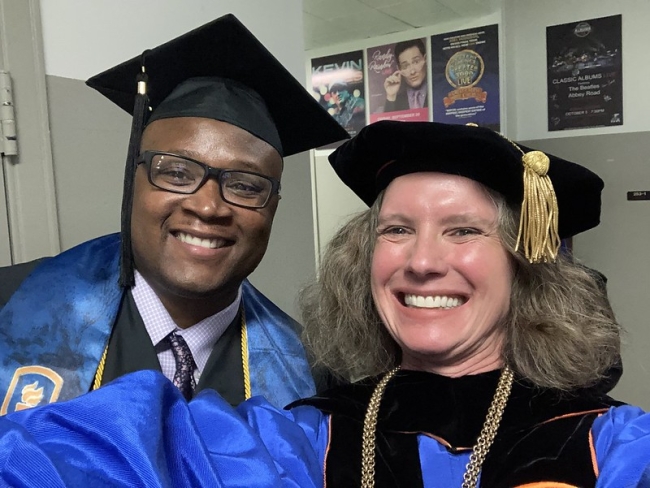You have /5 articles left.
Sign up for a free account or log in.

A new graduate poses with Empire State president Lisa Vollendorf at the 2023 commencement ceremony in Rochester, N.Y.
Empire State University
When you’re a higher ed professional, you get used to stories from exasperated people whose credits earned at one institution didn’t count at another. This costs students and families time and money and results in students stopping out rather than persisting to graduation. The recent Associated Press article about Ricki Korba’s frustrating experience with transferring from a community college to a university is just one example of how widespread the problem is.
Woefully few students attain their goal of earning a bachelor’s degree. According to the Community College Research Center, only 31 out of every 100 students who seek to transfer actually do so, and only 14 achieve a bachelor’s degree. Nationwide, students lose 40 percent of their credits upon transfer, and up to 10 percent of transfers receive no credit.
We can and should do better. There is no doubt that fixing the transfer system takes work. More transparent admissions and credit-transfer processes, including a robust array of transfer pathways, are needed. Advising should be integrated into the student life cycle to ensure the sharing of accurate information throughout the community college experience. It seems easy, but it’s not.
Changing the Mind-Set
To make this work, our collective mind-set must change. Four-year colleges and universities need to recognize that we exist to help drive educational attainment, not to keep students out. Only with this shift can we make a dent in the inequities that plague higher education.
Compared to four-year institutions, community colleges serve racially and socioeconomically diverse student populations. White and higher-income students transfer at rates double those of students of color and students in lower socioeconomic brackets. This drives differential outcomes at the bachelor’s level, where we continue to see fewer first-generation, Pell-eligible and BIPOC students graduating compared to their whiter, wealthier and continuing-generation counterparts.
We must respect the path that each student has taken to get where they are when they arrive at our universities. This requires that we begin by wanting to help students transfer credits and receive credit for life experience. Sadly, this framework is the exception, not the rule.
Shifting this mind-set requires a change in thinking as well as resources. Specifically, having timely and transparent credit evaluation—for credits earned elsewhere and for prior learning—enables four-year institutions to put students first. But most of all, it requires that universities look at every individual student as someone we want to help on their way to a bachelor’s degree.
We have known all this for years, but the time to act is now. The population with some credit and no credential nationwide is increasing at alarming rates. These 40.4 million people need us to take action. Public education is the most promising driver of social mobility in this country, but we are failing to respond effectively to the growing equity crisis.
Creating a Transfer-Friendly University
Empire State University, part of the State University of New York, is New York’s first and only public online university. We have made an explicit commitment to serve transfer students, and we know what it takes to successfully deliver on the transfer promise. We also know that we can we do this work better, so every day we use our data and student feedback toward continuous improvement efforts.
SUNY Empire’s commitment to transfers is multifold:
- While many institutions offer program-specific pathways from the associate to the bachelor’s, our pathways program goes one step further and guarantees admission to community college graduates.
- Students know that SUNY Empire is transfer-friendly: approximately 90 percent of our students arrive with transfer credits, and more than half of those students attended at least two other institutions. We have a sense of urgency around helping them map an achievable pathway to their bachelor’s because we know that these students have expended much of their financial aid before arriving at SUNY Empire.
- Where most institutions only accept up to 60 transfer credits—and often do so selectively—SUNY Empire accepts 100 percent of lower-division credits (up to 79). Moreover, we know that students often have taken upper-division credits, so we allow an additional 14 upper-division transfer credits (for a total of 93) toward a bachelor’s.
- Higher education has been slow to embrace credit for prior learning as part and parcel of how we assess students’ skills, competencies and knowledge transfer, yet SUNY Empire is an established national leader in credit for prior learning. We grant credit for a broad range of experiences that include work, professional licensure, standardized exams, apprenticeships, customer service preparation and fire, military and police training. This approach produces meaningful outcomes: more than 10,000 students earned their bachelor’s degree with us in the past five years, with a median time to degree of 2.8 years. This is possible because, on average, these graduates transferred 47 credits and earned an additional 13 credits through prior learning assessment.
- Our flexible approach has enabled Empire State University to be known as a public military-serving university. We awarded over 20 percent of the degrees granted to military-affiliated students by all SUNY institutions in the past five years.
- We have programs that are outcomes-driven, allowing students to demonstrate competencies rather than courses completed. On average, this inclusive approach saves Empire State University students $17,000 in tuition costs and as many as two years of study.
- SUNY Empire has a long and proud record of serving learners of all ages, striving to understand the whole student, not just their academic record, and to help them apply as many credits as possible toward their degree.
At all levels, Empire State University has a student-friendly ethos. This is evident in the following ways:
- Our functional units and academic departments know we are an access-driven university. Our faculty and staff work at SUNY Empire because of this mission: we are proud to be SUNY’s access institution.
- We wholeheartedly welcome a diverse student population—our 2023 graduates range from age 19 to 79 and represent, in broad terms, the racial and ethnic diversity of New York State. We serve multiple generations of students at the same time (currently baby boomers, Gen X, millennials and Gen Z) and work to constantly adapt our student services, professional development and processes to serve each generation as effectively as possible.
- Moreover, SUNY Empire is committed to affordability and inclusivity. Our in-state tuition is lower than 40 other states’ in-state rates. Our out-of-state tuition is lower than in-state tuition in 29 other states.
Most of all, we are committed to welcoming all students, meeting them where they are in their journeys and supporting them along the way.
Student Impacts
Transfer student Layla Vazquez has benefited from our transfer-friendly ethos. Prior to enrolling in an online bachelor’s degree program at Empire State University in fall 2022, Layla Vazquez attended Hunter College and earned her associate degree at LaGuardia Community College. Empire State University accepted all 90 of Layla’s credits, and she will complete her bachelor’s degree in social science this December. She is carrying a 4.0 GPA while working a demanding job as a child support advocate, and she plans to pursue her master’s degree in clinical social work after she completes her degree with us.
“The fact that Empire State University valued my previous credits and used them toward my bachelor’s made earning that degree possible. I saved time, I saved money and I didn’t feel like I had wasted my time on past courses I didn’t need. I’m well on my way to achieving my educational and career goals,” Layla says.
Layla’s story should be the rule, not the exception.
Let’s Flip the Transfer Model
It wasn’t that long ago higher education started talking about flipping the classroom, turning our centuries-old lecturing model on its head and inviting students to be active participants in their learning.
It is time for bachelor’s-granting institutions to flip the transfer model. Rather than creating barriers for students who start at community colleges, we must actively demonstrate our desire to serve those students. We need a new definition of student success, one that values transfer students and strives, in every way, to serve all students with integrity.
To reduce equity gaps and increase social mobility, we must all embrace a new mantra: Welcome, transfers!




